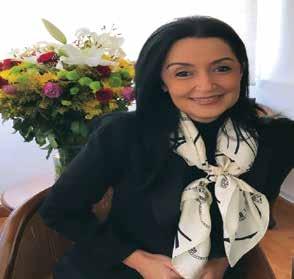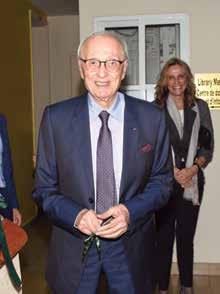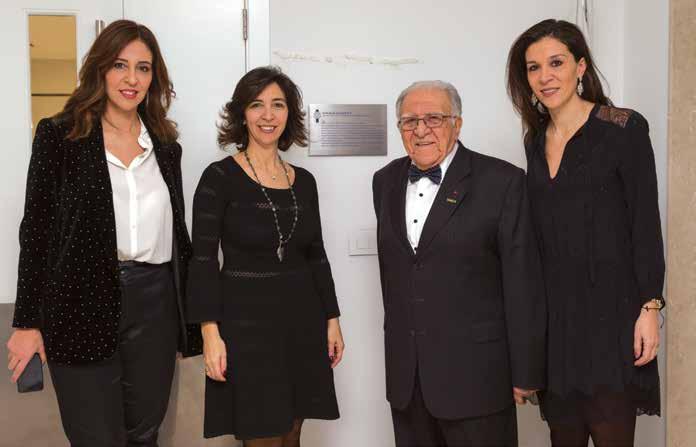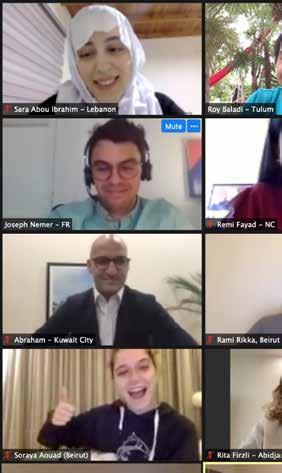
5 minute read
Saving the Sursock Palace
In a split second, it all went wrong.
Still, the dark wrought iron gates on the tree-lined Sursock street open wide. For those who want to comprehend. For those who wish to mourn. It was the ultimate blow. The destruction of the Sursock Palace.
The stately palace stood no chance. Its majestic open perch on an Ashrafieh hilltop gave the blast wave full permission to wreak havoc. Ironically, it was its verdant location that pushed Moussa Dimitri Sursock, a wealthy bourgeoisie merchant, to build his home among the fruit groves of Ashrafieh in the middle of the 19th century. Like many other wealthy Greek Orthodox families, he wanted to abandon Beirut’s city life and settle in the ‘countryside.’ It took seventeen years, but by 1870, Sursock Palace, with its spacious

Photos courtesy of Roderick Cochrane

lush green garden, was finally completed. Moussa moved in with his wife, three sons, and five daughters.
Since then, the palace walls quietly witnessed an avalanche of events. It saw the rise and establishment of the Sursock family among the highest circles of both the Ottoman and European political elites, and in fact, several Sursock family members held high positions in the Ottoman government. In time, the Sursock family adopted the style and manners of the French bourgeoisie. Many Sursock offspring ended up marrying into the aristocratic circles of Europe.
By the end of the 19th century, the family had reached the peak of their influence and were recognized as great merchants. Many business deals were most likely conducted in the palace, followed by lavish dinners. Despite the rapid decline of the Sursock dynasty during the French mandate, the house continued to witness Lebanese and European social elites frequenting its doors.
In 1946, Yvonne Sursock, the only child of Alfred Sursock and his Italian wife, Donna Maria Teresa Serra di Cassano, married Sir Desmond Cochrane, 3rd Baronet, an army officer in the British army and the Honorary Consul-General of Ireland for Syria and Lebanon, earning her the title of ‘Lady.’ Lady Cochrane would eventually inherit the Sursock Palace and bring up her four children on its grounds. It was a glamorous lifestyle. The family entertained lavishly. In his book, writer Philippe Jullian, published a book called The Snob Spotter’s Guide in 1958, saying that “if you want to be a really glamorous jet-setter, you had to have breakfast with the Maharaja of Jaipur, lunch with Desmond and Lady Cochrane in Beirut, and dinner with the Duchess of Alba in Seville.”
Recognizing the need to preserve the quickly disappearing historical homes of Lebanon, she founded the Association pour la Protection des Sites et Anciennes Demeures (APSAD), gathering famous Lebanese architects in her home and leading many campaigns and protests against the widespread demolition of old buildings. Her work came to an abrupt stop as the civil war erupted and claimed the palace itself as one of its victims. The Cochrane children dispersed, but Lady Cochrane stayed behind to defend the palace. (Sir Desmond passed away in 1979).
The palace survived. In 1997, Roderick Cochrane, one of Yvonne Sursock’s four children, returned to his childhood home with his American bride, Mary. The couple took up residence on the upper floor of the Sursock palace, still in shambles from the civil war days.
As luck would have it, Mary is an interior designer, and together, they threw themselves into restoring the palace. It looked hopeless at first. Unfazed, the couple began working. Many surprises awaited them. As they stripped away the paint, mesmerizing original colors appeared. An even bigger surprise was in store: attics that stored dozens of artifacts covered with layer upon layer of dust. Among them was a pair of 2.8m by 2.6m Gilbert paintings dating from 1891, wrapped in newspapers from 1903, and buried under rubble from wartime shelling. The paintings were thought to have been obtained by Roderick’s great grandfather Moussa Sursock himself. But
Roderick and Mary Sursock Cochrane would like to thank all IC students who showed up to their home after the blast with brooms, gloves, shovels, and especially their smiles. “They lifted our spirits and were very helpful,” said Mary.

there was more: chandeliers, shattered into hundreds of pieces, were painstakingly reassembled, and lamps, tiles, photographs, brassware, and mirrors. Also uncovered were dozens of old photos and painted portraits of people dressed in turn of the century clothing posing in the various parts of the palace. The portraits were carefully hung all over the palace walls. In a crate, sealed for 90 years, lay 15 panes of turn-of-the-century stained windows from Belgium – soon installed in the reception room. Several 19th-century trunks revealed all sorts of fabric, neatly folded with mothballs – aptly turned into curtains for the palace’s windows.
Finally, the palace was officially returned to its former glory – all of it refurbished in 19th-century furnishings. It was as if time had stood still. Only the gentle hissing sounds of the air conditioners and the warm lighting throughout the palace gave away the 21st century.
In 2002, the palace saw the birth of Ariana Sursock Cochrane ’20.
The vast garden was turned into an events venue. The income was used to support the upkeep of the mansion.
In July, a celebration was held in the garden. Ariana had turned 18.
August 4th .
There was nothing ominous that day. Roderick had left the palace. He had an appointment outside. Mary went to the


balcony facing the harbor, intrigued by the first blast. Ariana was in her bedroom. Lady Cochrane was downstairs in her home. At 98, she was remarkably nimble on her feet. 6:07 pm.
Only Ariana escaped uninjured. Both Lady Cochrane and Mary spent time in hospital.
Sursock Palace, the country’s 19thcentury landmark, was destroyed. The level of destruction was ten times worse than the destruction of the civil war. A hundred and fifty years’ worth of history was obliviated. It was a shocking blow to the entire Lebanese nation.
On August 31, Lady Cochrane passed away. She never knew the extent of damage to her beloved palace.
In a split second, it all went wrong.

Post the blast a decision was taken to open the palace as a private museum. It is estimated that its restoration will cost several million dollars. To raise the necessary funds, Roderick and Mary Cochrane have launched a fundraising campaign. If interested in helping to restore the landmark palace, please contribute to:
Bank Audi SAL Tabaris
Account :00088405-0010 Currency : USD IBAN LB82 0056 0000 0000 0008 8405 0010










